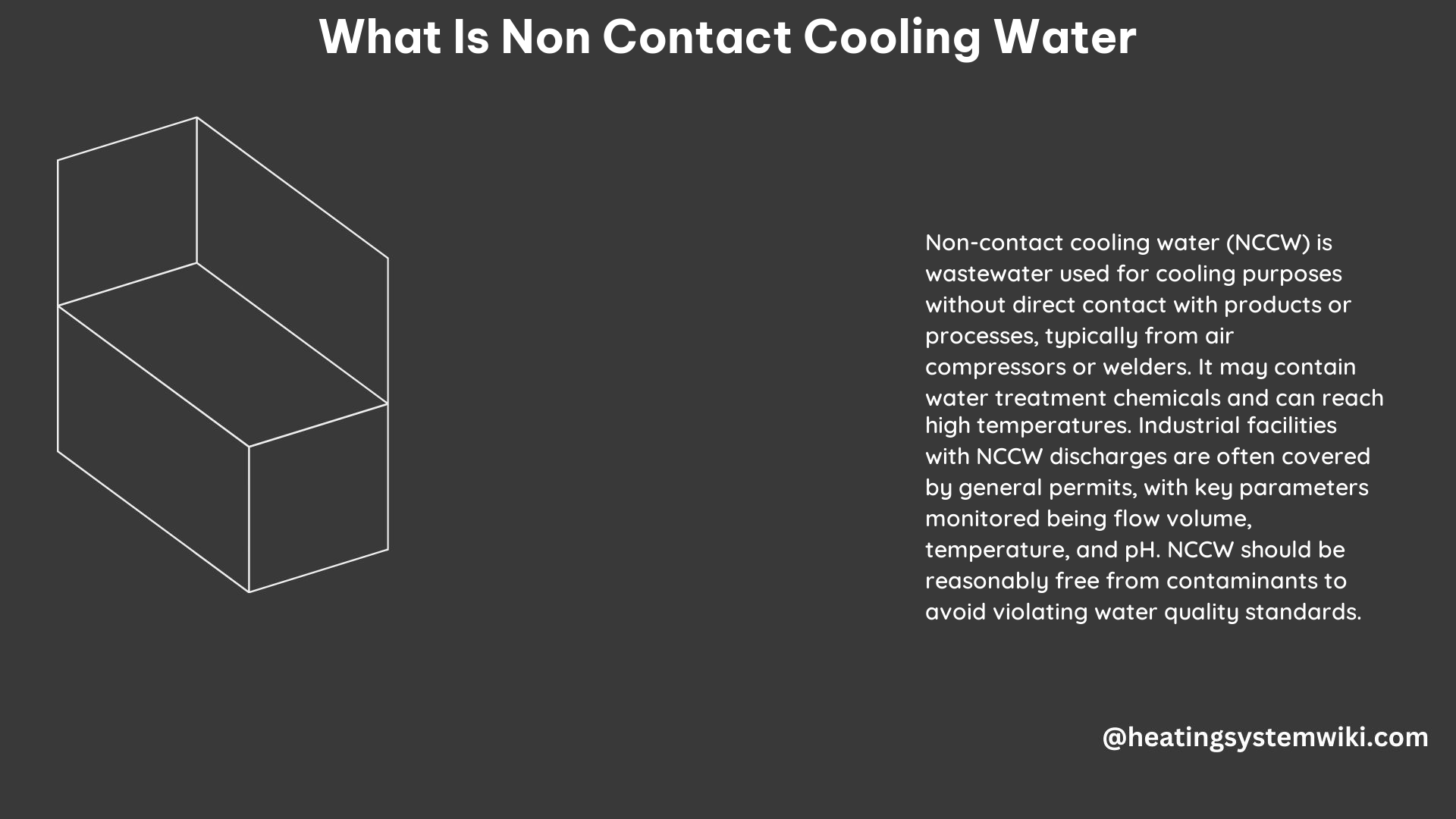Non-contact cooling water (NCCW) is a type of industrial water used to remove heat from various processes, such as air compressors, welders, and other industrial equipment, without coming into direct contact with raw materials, products, or other wastes. It is typically a once-through water system that does not mix with any other wastewater or process waters and is reasonably free from contaminants like metals, ammonia, organics, and total dissolved solids. NCCW is closely monitored for flow volume, temperature, and pH to ensure compliance with environmental regulations.
Technical Specifications of Non-Contact Cooling Water
The technical specifications of NCCW can vary depending on the industry and application, but some general guidelines include:
-
Temperature: NCCW should be designed to maintain a temperature below the maximum allowable limit, typically around 40°C (104°F), to prevent thermal pollution of the receiving waters. Exceeding this limit can disrupt the aquatic ecosystem and violate water quality standards.
-
Flow Rate: The flow rate of NCCW should be sufficient to remove the heat generated by the industrial process without causing erosion or other damage to the system or the receiving water. The flow rate is typically determined by the heat load and the desired temperature differential between the inlet and outlet of the system.
-
Chemical Composition: NCCW should be free from contaminants that could harm aquatic life or violate water quality standards. This includes metals (e.g., copper, zinc, lead), ammonia, organics, and total dissolved solids (TDS). The maximum allowable concentrations of these contaminants are often specified in the local or regional regulations.
-
Microbiological Content: NCCW should be free from pathogens and other microorganisms that could pose a risk to human health or the environment. This may require disinfection or other treatment processes, depending on the source and quality of the water.
-
pH: The pH of NCCW should be within the range of 6.0 to 9.0 to prevent corrosion or scaling of the system and to protect aquatic life in the receiving water. Maintaining the appropriate pH can be achieved through chemical treatment or by selecting materials that are resistant to corrosion.
-
Turbidity: NCCW should be free from suspended solids that could reduce the clarity of the receiving water and harm aquatic life. The maximum allowable turbidity is often specified in the local or regional regulations.
-
Conductivity: NCCW should have a low conductivity to prevent the discharge of high levels of dissolved solids that could harm aquatic life or violate water quality standards. Conductivity is a measure of the ability of the water to conduct electricity and is directly related to the concentration of dissolved ions.
These technical specifications can be achieved through various design and operational measures, such as proper system sizing, material selection, and chemical treatment. Regular monitoring and maintenance of the NCCW system are also essential to ensure compliance with the applicable regulations and to protect the receiving water body.
DIY (Do-It-Yourself) Non-Contact Cooling Water System

Building a DIY NCCW system can be a complex undertaking, but it can be done with the right knowledge and resources. Here are the key steps to consider:
-
Assess the Heat Load: Determine the amount of heat that needs to be removed from the industrial process. This will help you select the appropriate size and capacity of the NCCW system. Consider factors such as the process equipment, operating hours, and environmental conditions.
-
Select the Cooling Medium: Choose a cooling medium, such as water or a glycol-water mixture, that is appropriate for the temperature range and other requirements of the system. Water is the most common cooling medium, but glycol-water mixtures may be used in applications with lower temperature requirements or where there is a risk of freezing.
-
Design the System: Design the NCCW system to meet the flow rate, temperature, and other specifications required for the application. This may include selecting the appropriate materials, pumps, heat exchangers, and other components. Consider factors such as the system’s pressure drop, heat transfer efficiency, and energy consumption.
-
Install the System: Install the NCCW system according to the design specifications and any applicable regulations or codes. This may involve obtaining permits, coordinating with local authorities, and ensuring that the system is properly integrated with the industrial process.
-
Monitor and Maintain the System: Regularly monitor the NCCW system to ensure that it is operating within the required specifications. Perform routine maintenance, such as cleaning heat exchangers, replacing filters, and checking for leaks or other issues, to prevent corrosion, scaling, and other problems.
It’s important to note that designing and building a DIY NCCW system requires a thorough understanding of the principles of heat transfer, fluid dynamics, and materials science. It is recommended to consult with a qualified engineer or technician to ensure that the system is designed and installed correctly and meets all applicable regulations and codes.
References
- Wisconsin Department of Natural Resources. (2016). Noncontact cooling water or condensate and boiler water fact sheet. Retrieved from https://dnr.wisconsin.gov/sites/default/files/topic/Wastewater/44938FS.pdf
- Ohio Environmental Protection Agency. (2021). Non-Contact Cooling Water – General Permit. Retrieved from https://epa.ohio.gov/divisions-and-offices/surface-water/permitting/non-contact-cooling-water–general-permit
- Law Insider. (n.d.). Non-contact cooling water Definition. Retrieved from https://www.lawinsider.com/dictionary/non-contact-cooling-water
